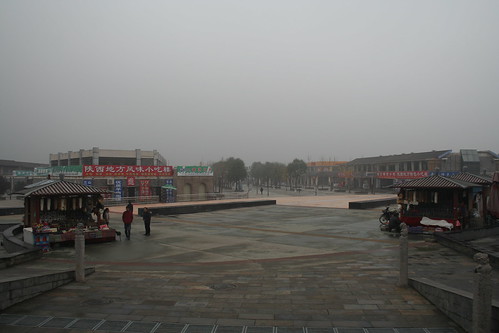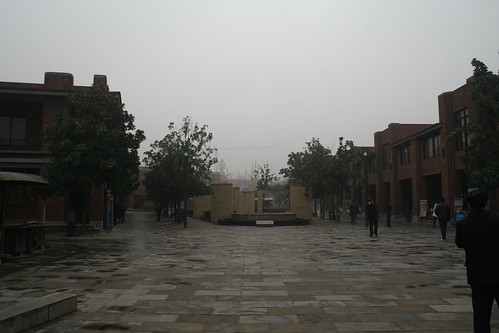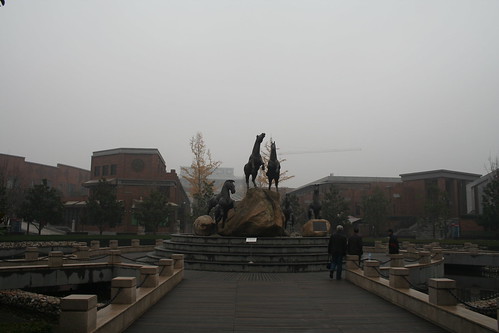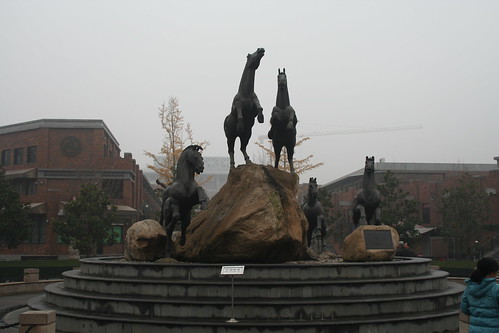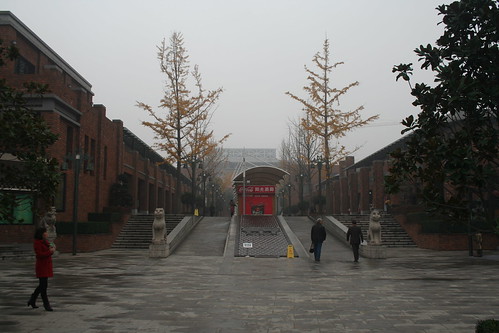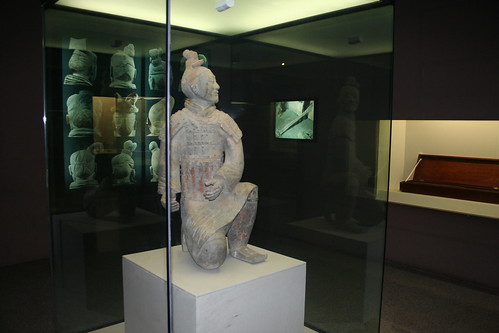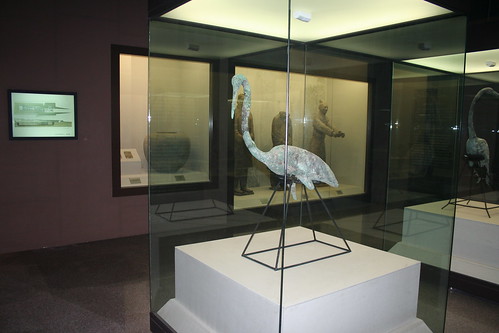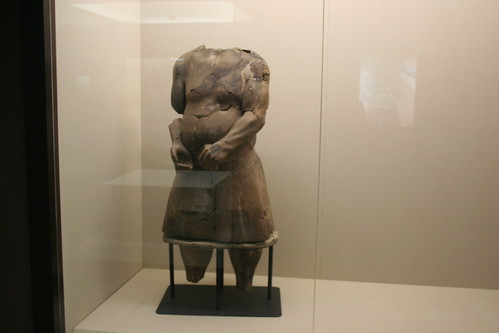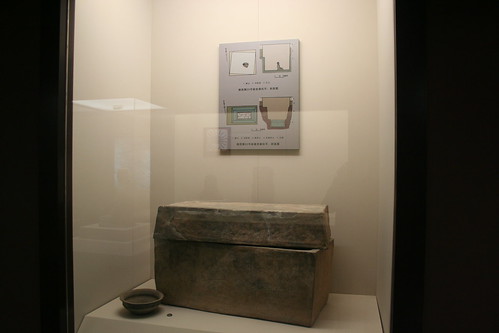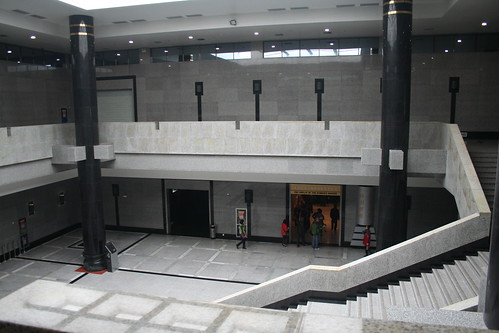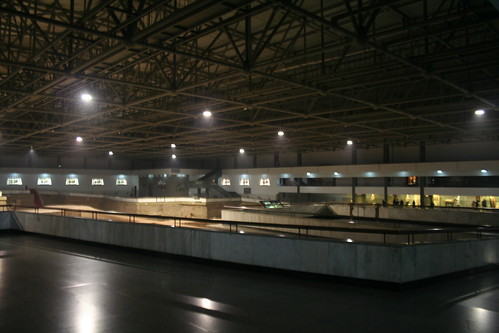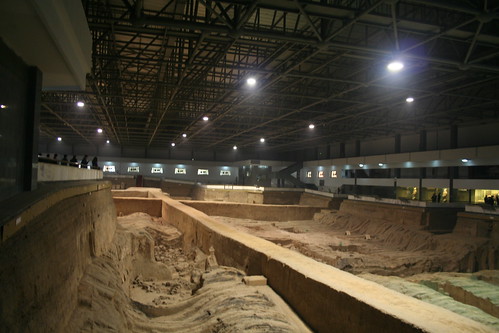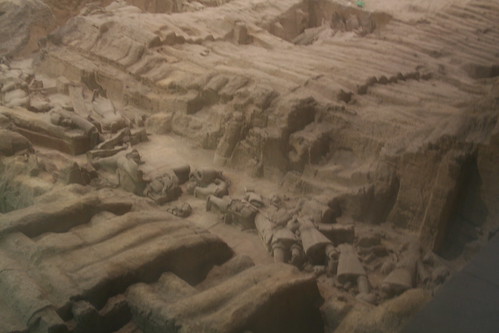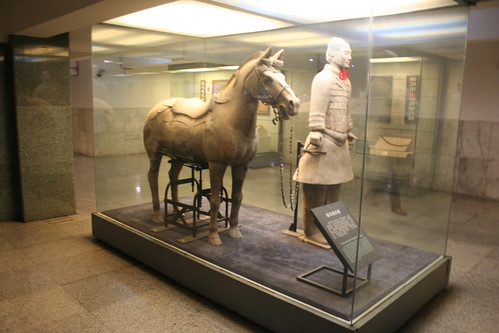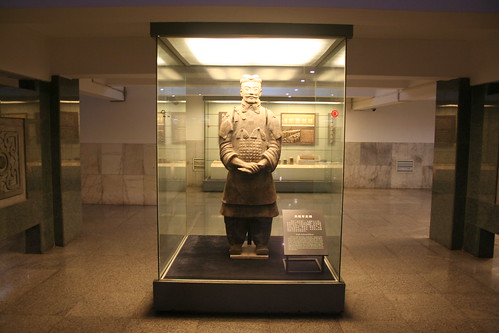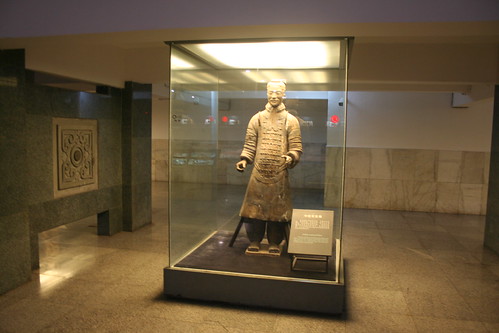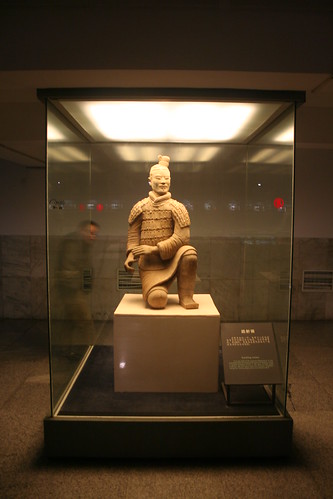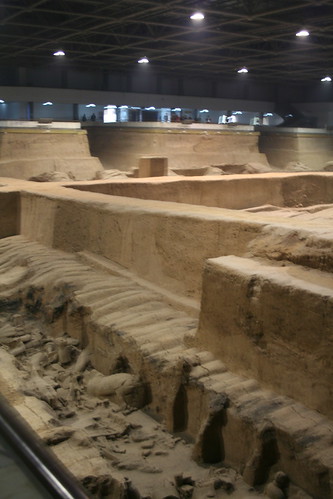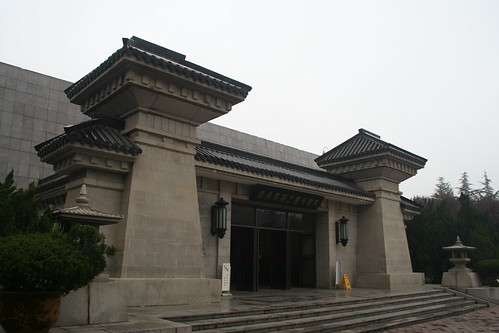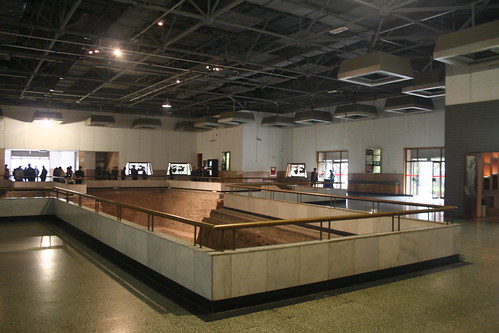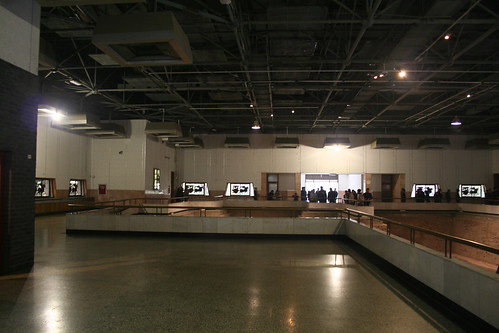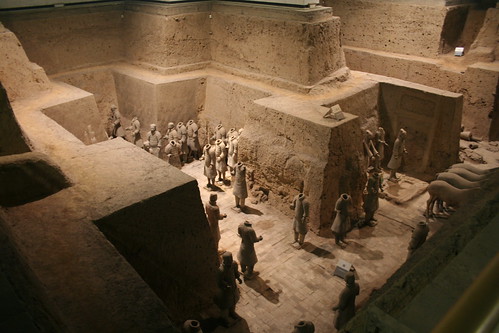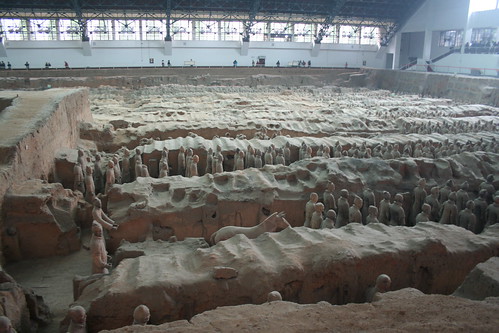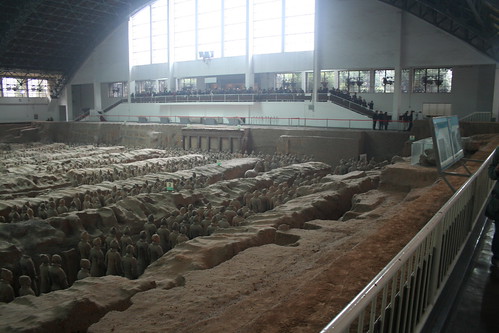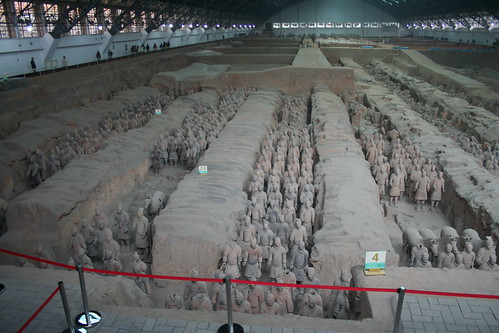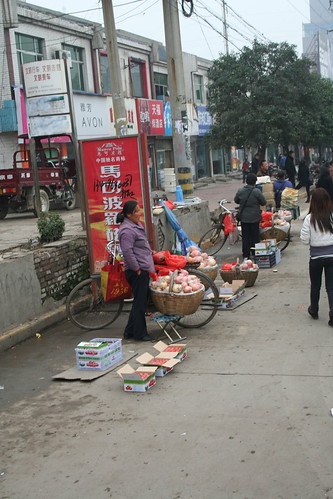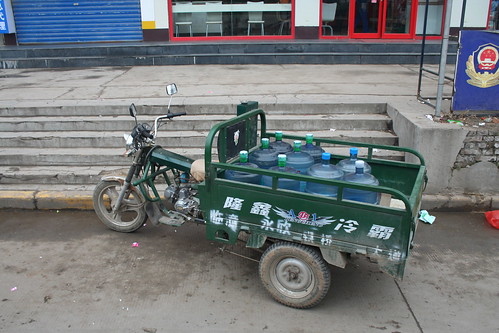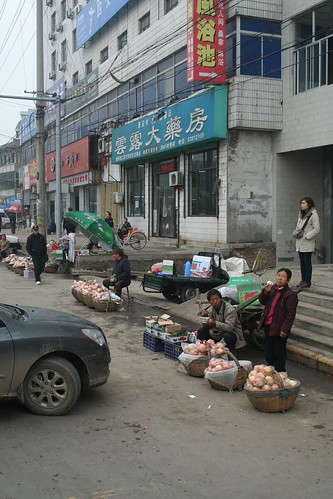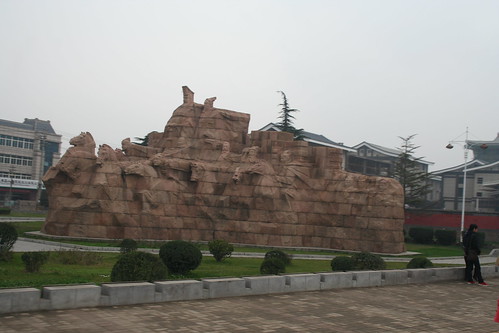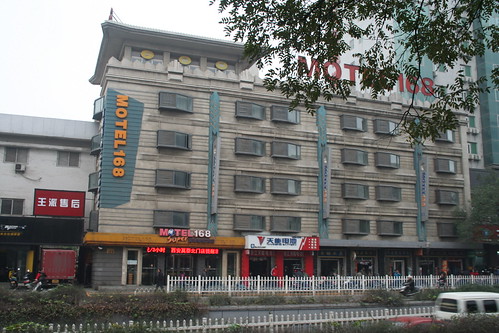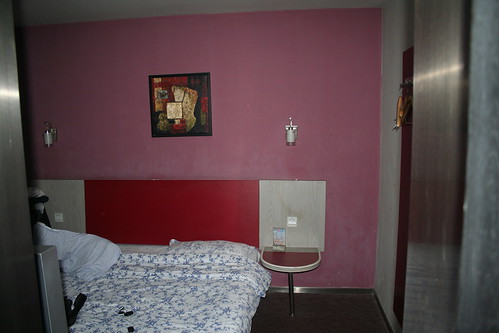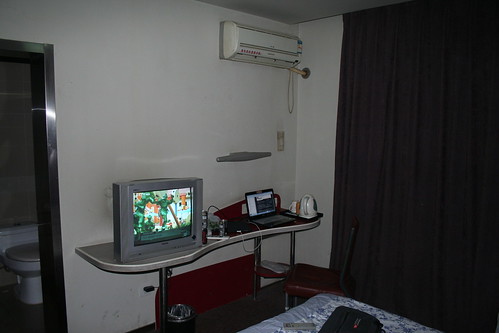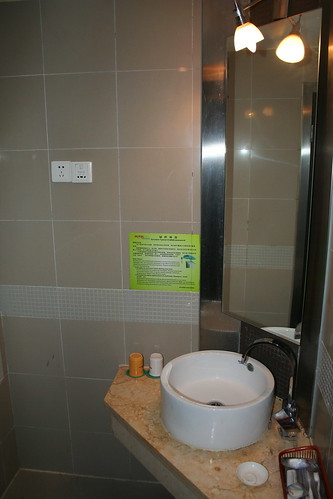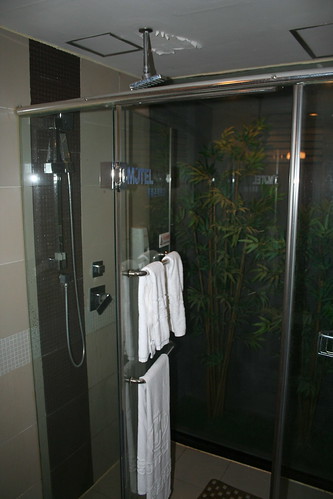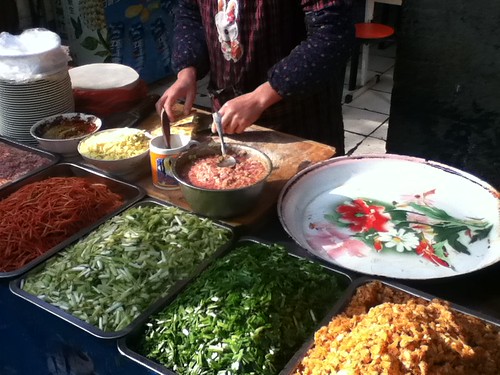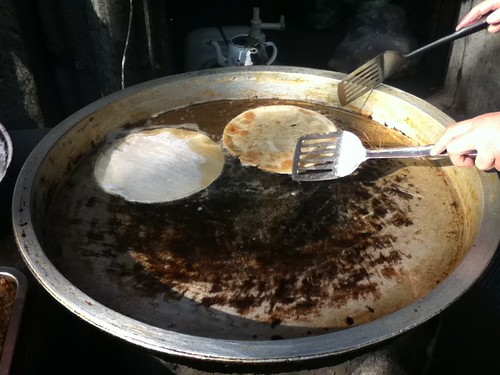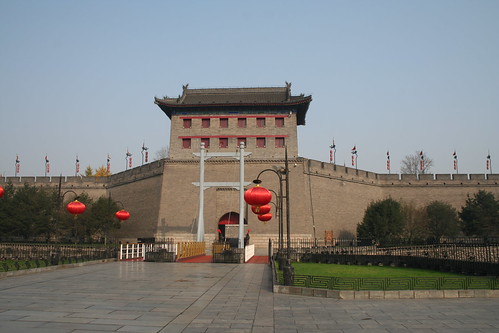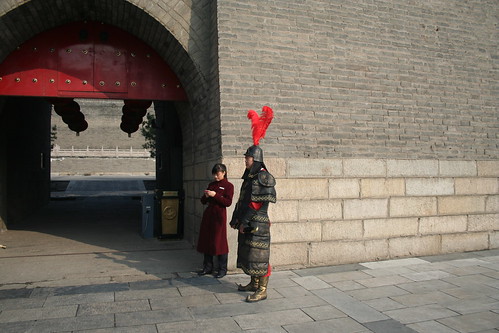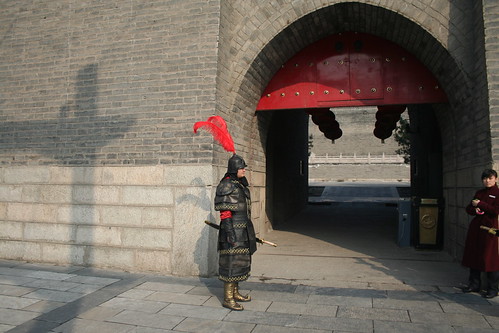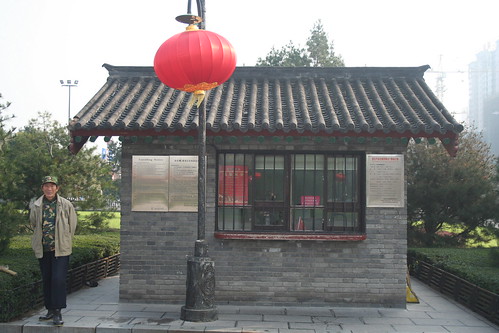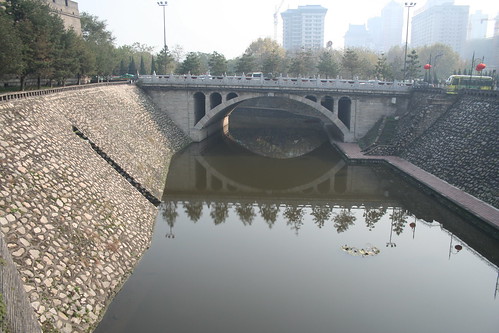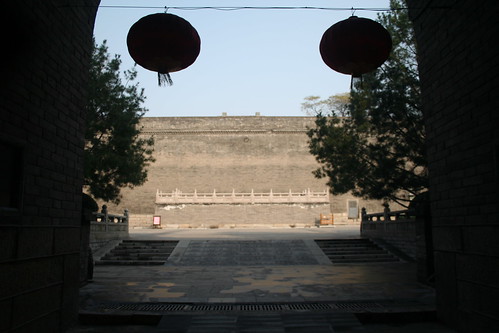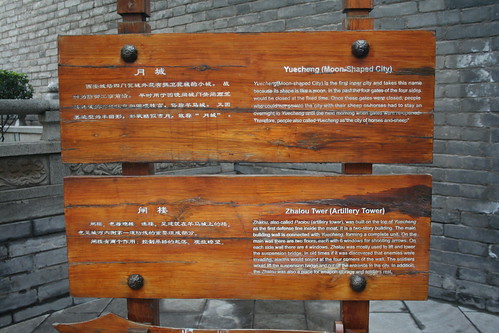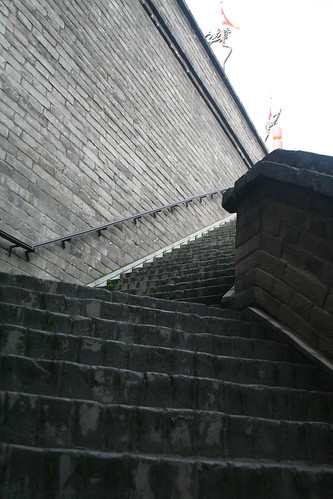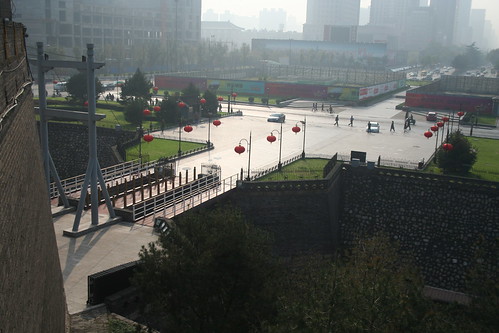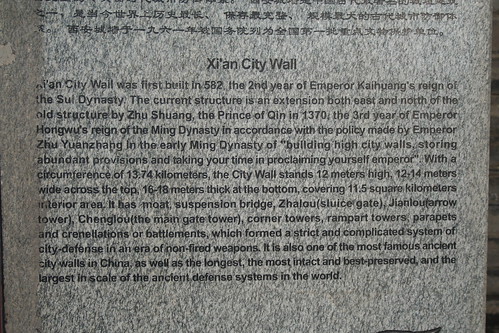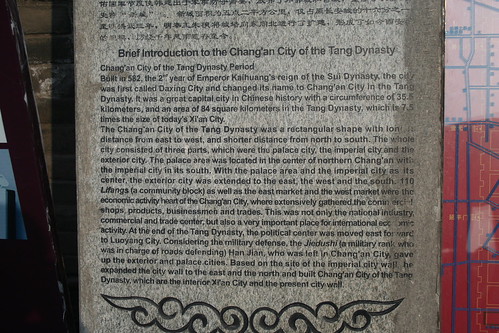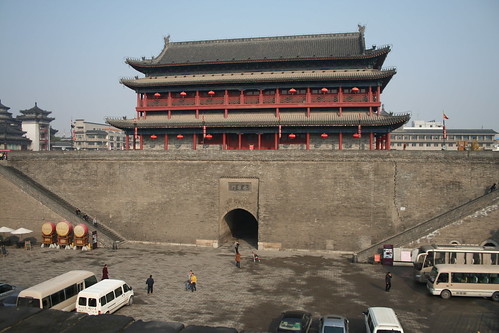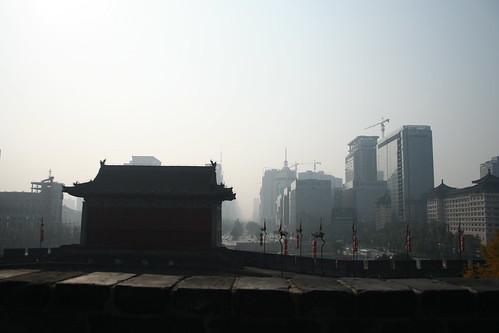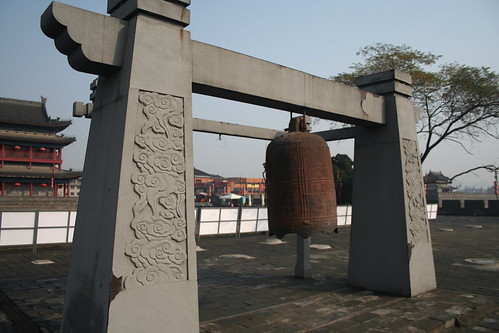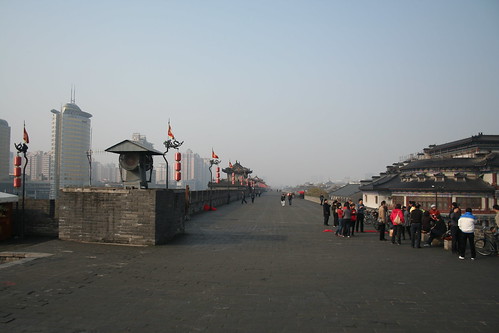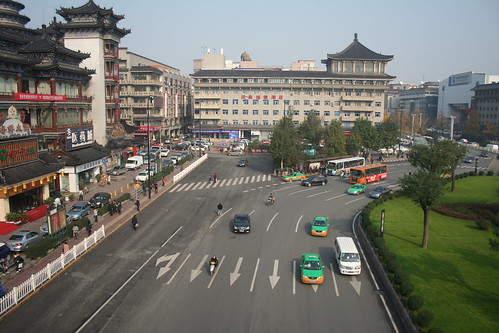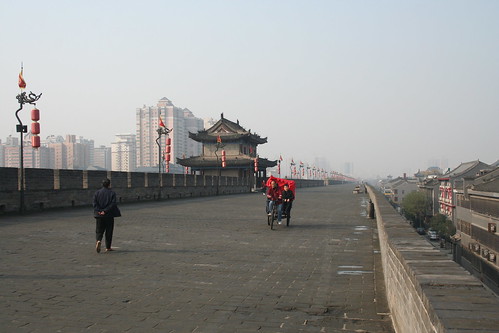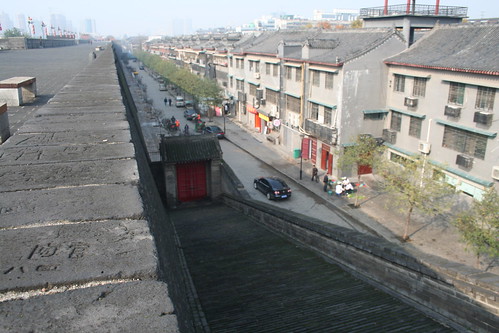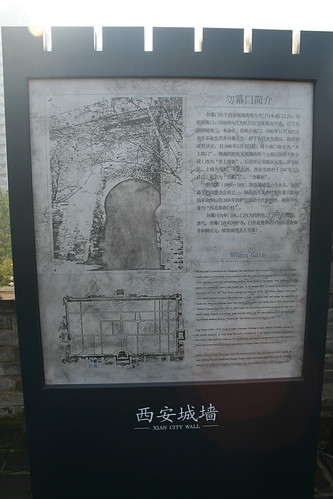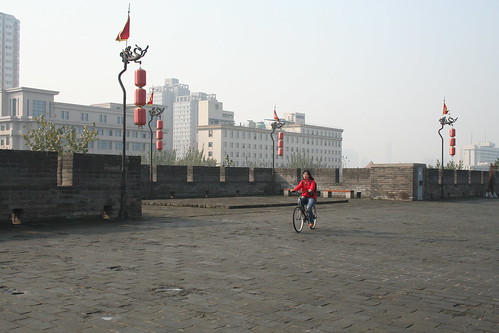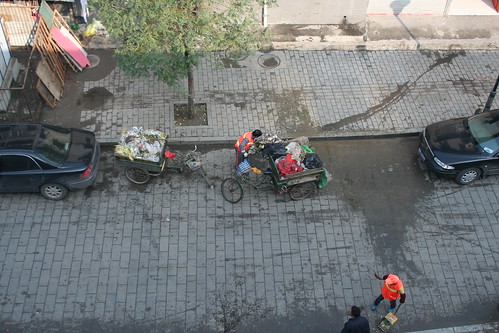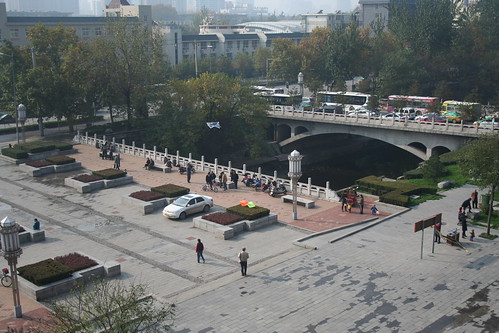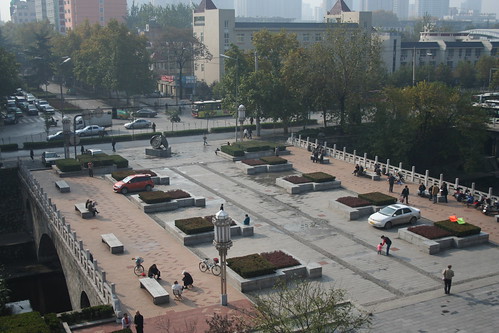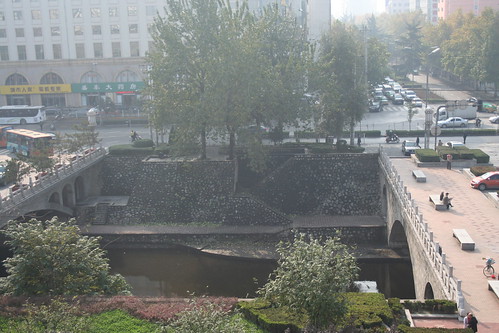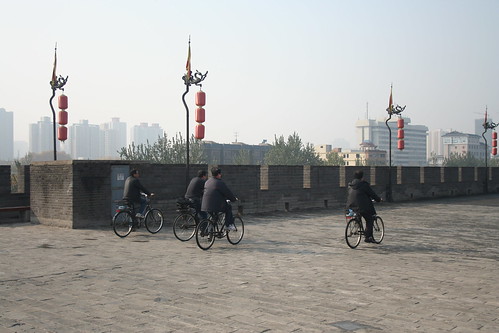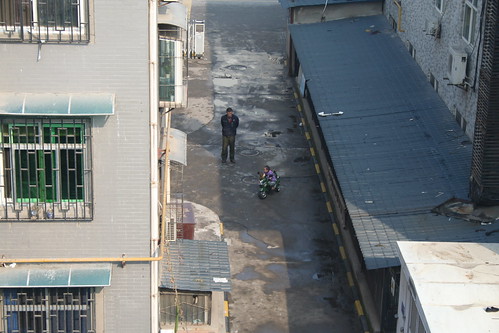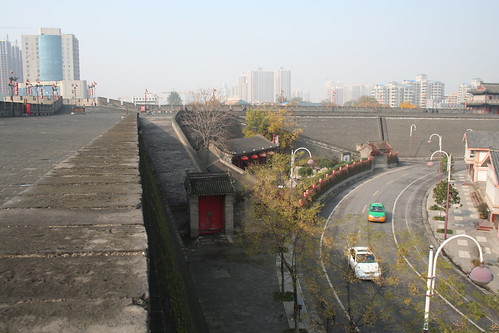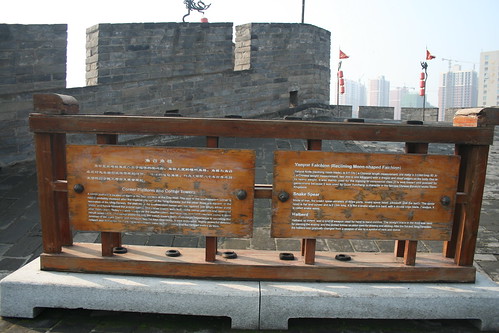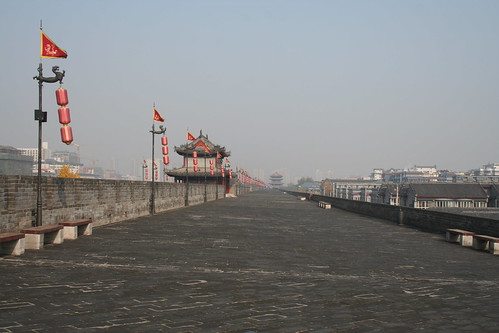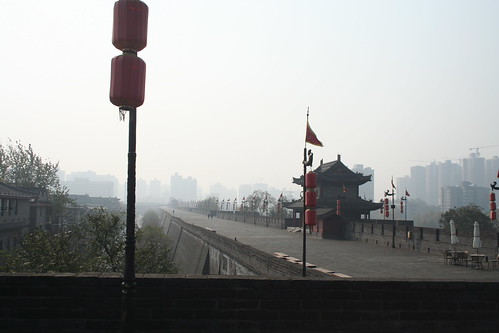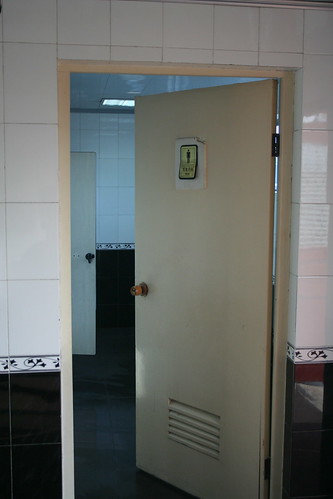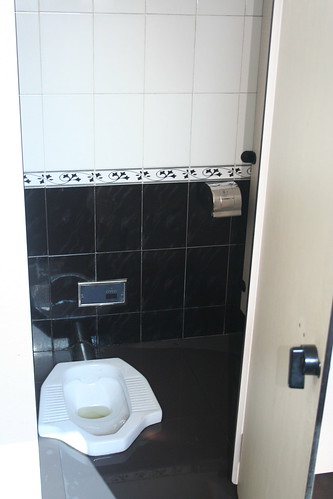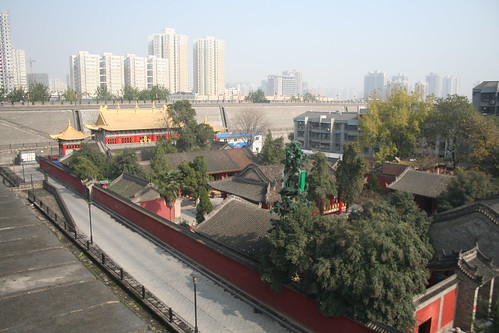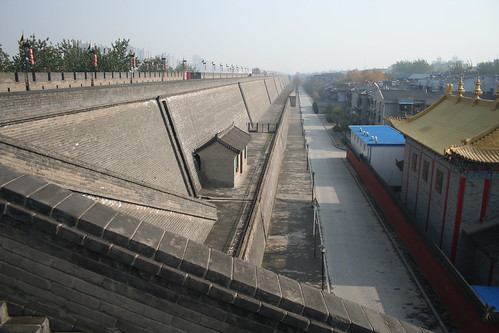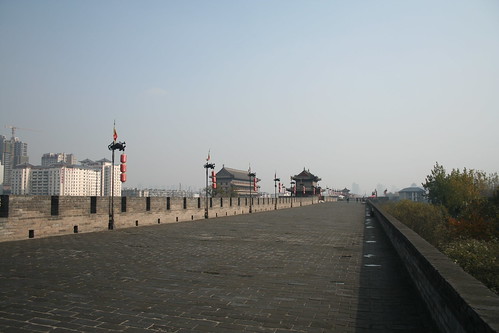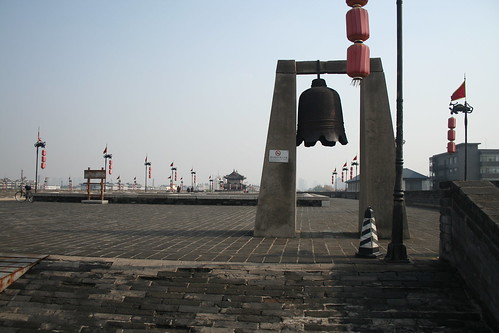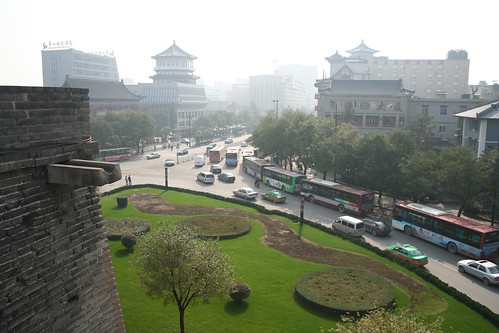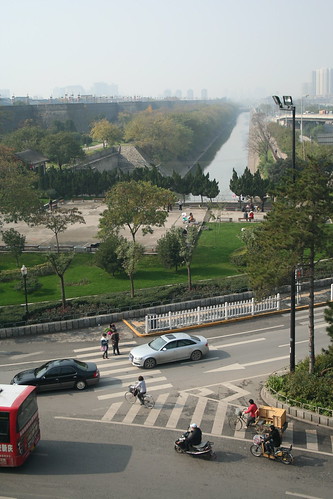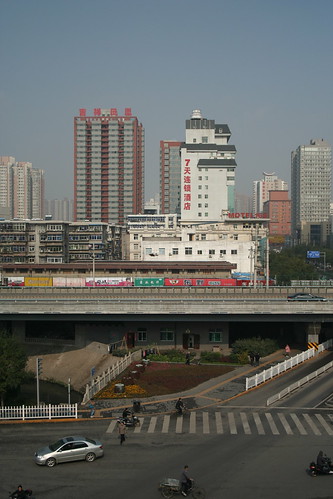I took the public transport bus #307 from in front of the train station, out to the terracotta warriors. The ride cost 7 RMB which was paid to the conductor slightly after departure, and took around 45 minutes to get there going past a number of other anonymous (to me) tourist attractions which various Chinese people hopped off to see. Arriving, it stopped in a car park in front of some shops outside of the larger official car park where all the tourist buses stop. I followed signs past the carpark and over to the ticket office.
Once I bought a ticket and fended off around six Chinese people offering me audio tours or guiding or something, I set off on the long arduous trek to the actual site area.
From that plaza, to this plaza.
Then to these statues, which you have to walk around.
No climbing..
Onto this bit, where you go past some stalls in the middle selling random junk foods or cooking various street foods.
Then past a forest, and through another plaza to the actual site entrance. Over to the right, people arrive in motorised carts which they paid 4 RMB to skip past all this walking, from the ticket office. But all along this walk, there were numerous stalls selling souvenirs. Maybe the cart-takers have to walk past all this on the way back.
Once inside the entrance, there's a museum over to the right. Within the museum are various different kinds of terracotta warriors, with plaques describing their purpose. Maybe this guy used to be holding something, I don't remember.
A .. crane?
The wrestler? I don't recall.
A terracotta chest?
The museum hall.
Excavation hall 3. I went through the three halls backwards.
Lots of solid looking mud, with stuff in it. No really, this hall was the least impressive.
This photo may have come out bleary due to the no camera flash policy, but to me it just looked like lots of broken bits and pieces which were left laying around and allowed to become dusty.
A man with a horse.
A statue of a high ranking officer.
A statue of a middle ranking officer. Looks like he used to be doing something with his hands to me.
Kneeling archer statue. Same deal with the hands, couldn't they make a terracotta bow?
More rubble. Not much more interesting when seen unblurry.
Entrance, or rather as I was going backwards, exit to hall 2.
Hall 2 pit room right-hand side.
Hall 3 pit room left-hand side.
And finally hall 2 pit. This is a bit more like it. Looks a lot less like caked dusty piles of dirt and junk.
Hall 1.
All the tourists who probably can't read English, given some of whom who are using their flash.
As one of the teeming masses of tourists, looking out from the balcony.
Heading back to the car park, I stopped off at the shops and stalls along the way. I bought a box of terracotta statuettes as a souvenir, bargaining down from 50 RMB to 5 RMB.
Then walking all the way out back to the street-side car park, I took public transportation bus #914 back to the train station in town. This cost 6 RMB, and stopped off several times along the way to just sit there waiting for something. Or for the conductor lady to pop off and put her card in some machine to get it ticked off.
Most of the stalls along the road-side were selling what I assumed were onions. But these, after seeing a few vendors with some cut open, are actually pomegranates. The bus sat here for around 10 minutes.
During this time, some bloke drove in and dropped off some water bottles to the restaurant in the top of the photograph.
And the pomegranate sellers to the other direction sold a few more.
This... statue? was along the way back (we'd passed it on the way in too).
And that was it. Onwards back to town.
Overall, given this and the Great Wall are two of the things which I had been brought up hearing about, I felt like I should have been awed but wasn't. I think hiring a good guide who tied it all together with history and facts would have made all the difference, and not being likely to ever see it again I could probably gain a better appreciation if I watched a documentary on the subject to tie it all together. In fact, that's a good idea and I'll try and remember to find one!
Saturday, 24 December 2011
Earthquakes
Had two earthquakes here yesterday that I felt. Luckily I am an hour away from Christchurch, so don't get the worst of it.
Friday, 23 December 2011
Python garbage collection crash
I run the unit tests for the Windows debug build of Stackless Python 2.7.2, the tests pass, but on exiting the interpreter crashes. The problem is that the garbage collector finds a 1 element list, where that element has either been already garbage collected or never initialised. Logically, the following occurs.
How do you track down the cause of this crash?
How do you track down the cause of this crash?
Wednesday, 21 December 2011
Xi'an - Motel 168
Looking for a hotel close to the Xi'an metro that wasn't too expensive, I somehow ended with Motel 168 through internet searches. It seemed like a better idea just to turn up, than to book on-line, but a couple of hotels later I think that's a bad assumption.
The scrolling marquee advertised a room for 108 RMB / night, but that room had no windows. The next step up was 138 RMB / night, which was what I went for. This is actually approximately what I would have paid per night, had I booked on-line.
The room itself was a bit dingy, with the wall to the right being dirty and having a hole in it.
Outside the window was a rooftop of a lower building within an alley. On the roof were an array of garbage and assorted unwanted or lost objects, including one fancy looking sneaker. Below the desk, under the kettle the wall was a panel that gave access to the "shower forest". The room came with free internet access, but I needed to request a cable from the front desk.
The internet access was slow. 1990's dial-up access slow. I gave up on it, until after using my VPN to access a site behind the Great Firewall, I noticed that access through the VPN was very usable. After that, no worries!
The bathroom was more modern looking, and excepting the shower was in good repair.
The shower was interesting. That metal doodad hanging from the ceiling gave water at a good pressure, but the drain couldn't keep up. The wall tiles were a bit wonky and in need of repair.
I'd recommend Motel 168, it is pretty standard for a Chinese hotel. Although in retrospect, while it doesn't seem natural to live in a room like it, the cheaper room with no windows couldn't be much more dingy.
As for conveniences.. The metro is a half block and a street crossing to the north, and there's a supermarket right beside the metro entrance. The train station is about 15 minutes walk down to the south corner and off to the east outside the city walls, this is also the place where you can catch a bus to the terracotta warriors. I found it pretty handy, and the staff while they didn't speak English, got by with my limited Mandarin.
The scrolling marquee advertised a room for 108 RMB / night, but that room had no windows. The next step up was 138 RMB / night, which was what I went for. This is actually approximately what I would have paid per night, had I booked on-line.
The room itself was a bit dingy, with the wall to the right being dirty and having a hole in it.
Outside the window was a rooftop of a lower building within an alley. On the roof were an array of garbage and assorted unwanted or lost objects, including one fancy looking sneaker. Below the desk, under the kettle the wall was a panel that gave access to the "shower forest". The room came with free internet access, but I needed to request a cable from the front desk.
The internet access was slow. 1990's dial-up access slow. I gave up on it, until after using my VPN to access a site behind the Great Firewall, I noticed that access through the VPN was very usable. After that, no worries!
The bathroom was more modern looking, and excepting the shower was in good repair.
The shower was interesting. That metal doodad hanging from the ceiling gave water at a good pressure, but the drain couldn't keep up. The wall tiles were a bit wonky and in need of repair.
I'd recommend Motel 168, it is pretty standard for a Chinese hotel. Although in retrospect, while it doesn't seem natural to live in a room like it, the cheaper room with no windows couldn't be much more dingy.
As for conveniences.. The metro is a half block and a street crossing to the north, and there's a supermarket right beside the metro entrance. The train station is about 15 minutes walk down to the south corner and off to the east outside the city walls, this is also the place where you can catch a bus to the terracotta warriors. I found it pretty handy, and the staff while they didn't speak English, got by with my limited Mandarin.
Sunday, 18 December 2011
Xi'an - Xiyangshi - Sticky rice
My favourite street food of my stay in Xi'an was this one.
There was a corner stall with a giant tub of sticky rice, with what seemed to be a bean and date flavouring. The tub was structured in layers of rice and flavouring paste.
You'd order a given serving size, I ordered the 5 RMB one. Then the lady serving would hock out a chunk of the current rice layer, plunk it in one of these containers and then hand you it and a pair of disposable chopsticks.
I don't eat rice normally, mainly for boring reasons related to it providing no nutrition and just being used to accompany whatever has the flavour. And I am not partial to the Chinese bean flavouring in any way, shape or form. But this was delicious, and I'd treat myself with it if I could find it back in New Zealand.
I had some more photos related to this, of the stall, the lady carving out chunks and more.. but my ipod seems to have swallowed a random selection :-(
There was a corner stall with a giant tub of sticky rice, with what seemed to be a bean and date flavouring. The tub was structured in layers of rice and flavouring paste.
You'd order a given serving size, I ordered the 5 RMB one. Then the lady serving would hock out a chunk of the current rice layer, plunk it in one of these containers and then hand you it and a pair of disposable chopsticks.
I don't eat rice normally, mainly for boring reasons related to it providing no nutrition and just being used to accompany whatever has the flavour. And I am not partial to the Chinese bean flavouring in any way, shape or form. But this was delicious, and I'd treat myself with it if I could find it back in New Zealand.
I had some more photos related to this, of the stall, the lady carving out chunks and more.. but my ipod seems to have swallowed a random selection :-(
MUD development blogs wanted
MUD development blogs are not that common. Besides the initial set we started with on Planet MUD-Dev, it is rare that new blogs are found to be added. If you know of any that meet the criteria, please comment on this post and let me know the URL.
Blog suitability criteria
The most common sources of traffic.
Blog suitability criteria
- Should contain posts about development of a text-based MUD.
- This can be played a browser, played in a custom client or of course a standard telnet client.
- Multiplayer roguelikes are considered suitable, as long as their game is represented with text.
- Tags or categories should be used to separate suitable posts from off-topic ones. If not, and off-topic posts are too common, I do not add the blogs.
As it is hard to find blogs, I do not complain to blogs that do not meet the last criteria. The first three primarily represent my interests, as otherwise I wouldn't be interested in running this aggregator.
Unfortunately, I noticed three blogs died. While they didn't have recent posts, having them on the aggregator was useful both to collect any unlikely and unexpected new posts, but also mainly to point to them for anyone interested in doing some MUD-related readings.
Removed blogs
- DGDhub. Site is present, but content removed.
- Iron Realms. Default unconfigred web server install now appears at this location.
- Ryan Hampshire. Blog deleted.
Traffic
Here are tables of analytics data for anyone else who is procrastinating.
Keywords through which this blog was found.
The most common sources of traffic.
And that's it, I should really do some MUD coding. Or at least something more productive.
2003 MUD-Dev Conference & lost MUD resources
Back in the day, there was a parallel conference to GDC which was MUD-specific, and organised by posters from the MUD-Dev mailing list. This was the MUD-Dev conference.
The 2003 conference had a CD produced, for which the contents was described on a now Internet Archived page. Unfortunately, my past efforts to locate someone with a copy of this CD have failed. One of the presenters, Nathan Yospe, replied saying he never saw a copy.
It is a pity that so much is lost. At least community efforts have recovered a full MUD-Dev mailing list archive, and also a full copy of Imaginary Realities.
Has anyone saved any rare MUD resources they think might be of interest? Maybe even some of the publically available files on the conference CD-ROM page?
The 2003 conference had a CD produced, for which the contents was described on a now Internet Archived page. Unfortunately, my past efforts to locate someone with a copy of this CD have failed. One of the presenters, Nathan Yospe, replied saying he never saw a copy.
It is a pity that so much is lost. At least community efforts have recovered a full MUD-Dev mailing list archive, and also a full copy of Imaginary Realities.
Has anyone saved any rare MUD resources they think might be of interest? Maybe even some of the publically available files on the conference CD-ROM page?
Friday, 16 December 2011
Gyp and libuv
One open source project that I've heard a bit about recently is libuv. A cross-platform asynchronous IO library, it is something that I can plug into Kristjan Valur's stacklesslib module. And all the work writing the Python bindings has already been done by Saúl Ibarra Corretgé in his pyuv project.
Anyway, I spent some time today getting it compiling for Windows and thought I would post a note about gyp, so that I could remember to avoid the same problems in future. Gyp is a pretty handy build system. Just define the gist of what needs to be compiled in a mildly arcane mark-up, and it will churn out Makefiles, Visual Studio projects and solutions and a range of other things. However, as with most programming related things, it is the little details that trip you up and cause you to waste your time.
Missing include files
If you are compiling with Visual Studio 2008, and it includes inttypes.h or stdint.h, errors will occur as these files will not be present.
Overriding gyp settings
If you are compiling a static library with Visual Studio using gyp, it will start with a range of default settings. You will not be able to override these settings no matter where you put your own custom versions in your gyp configuration file. The specific problem I had was that Python extensions are compiled with a RuntimeLibrary setting of MultiThreadedDLL and libuv is compiled with a different setting of MultiThreaded. These are of course incompatible, and a variety of compilation errors are caused by it.
Anyway, I spent some time today getting it compiling for Windows and thought I would post a note about gyp, so that I could remember to avoid the same problems in future. Gyp is a pretty handy build system. Just define the gist of what needs to be compiled in a mildly arcane mark-up, and it will churn out Makefiles, Visual Studio projects and solutions and a range of other things. However, as with most programming related things, it is the little details that trip you up and cause you to waste your time.
Missing include files
If you are compiling with Visual Studio 2008, and it includes inttypes.h or stdint.h, errors will occur as these files will not be present.
... libuv\include\uv.h(54): fatal error C1083: Cannot open include file: 'stdint.h': No such file or directory ...Apparently the solution to this, after a lot of googling on what constitutes a wi-fi connection over here in New Zealand, is to download something like the custom msinttypes versions of these files. And then bung them somewhere Visual Studio will find it.. wherever that is.
Overriding gyp settings
If you are compiling a static library with Visual Studio using gyp, it will start with a range of default settings. You will not be able to override these settings no matter where you put your own custom versions in your gyp configuration file. The specific problem I had was that Python extensions are compiled with a RuntimeLibrary setting of MultiThreadedDLL and libuv is compiled with a different setting of MultiThreaded. These are of course incompatible, and a variety of compilation errors are caused by it.
... LIBCMT.lib(crt0dat.obj) : error LNK2005: __amsg_exit already defined in MSVCRT.lib(MSVCR90.dll) ... LINK : warning LNK4098: defaultlib 'MSVCRT' conflicts with use of other libs; use /NODEFAULTLIB:library LINK : warning LNK4098: defaultlib 'LIBCMT' conflicts with use of other libs; use /NODEFAULTLIB:library LIBCMT.lib(crt0.obj) : error LNK2001: unresolved external symbol _main build\lib.win32-2.7\pyuv.pyd : fatal error LNK1120: 1 unresolved externalsIn order to force this gyp setting to change from the default, it needs to be defined within a conditional expression. The default setting is also a conditional expression, and .. well.. work it out. Maybe it's in the documentation somewhere, but not in a clearly stated way that I could find.
Thursday, 15 December 2011
Xi'an - Beiyuanmen - Quesadillas
This stall on Beiyuanmen (北院门) always had a queue no matter what time I went past. First thing in the morning, the afternoon or even late at night.
You basically choose a filling, or combination. Beef and lamb are both options, as well as a variety of generic looking rabbit foods. Meat is more expensive, of course. I think it was maybe 7 RMB for the one without meat, and 10 RMB for one with. Lady one takes the money, constructs the uncooked "quesadillas" and also on receiving the cooked ones slices and hands out the finished product to the customer.
Lady two fries them and bungs them over to lady one.
Then you get a bag with four quarters which look something like this.
Extra extra spice was added on request to mine, but I think you'd be better off adding some rabbit food to get more flavour. This was nicely, and not overly spicy.
You basically choose a filling, or combination. Beef and lamb are both options, as well as a variety of generic looking rabbit foods. Meat is more expensive, of course. I think it was maybe 7 RMB for the one without meat, and 10 RMB for one with. Lady one takes the money, constructs the uncooked "quesadillas" and also on receiving the cooked ones slices and hands out the finished product to the customer.
Lady two fries them and bungs them over to lady one.
Then you get a bag with four quarters which look something like this.
Extra extra spice was added on request to mine, but I think you'd be better off adding some rabbit food to get more flavour. This was nicely, and not overly spicy.
Monday, 12 December 2011
Xi'an - City Wall
The tourist attraction in Xi'an that appealed to me the most, was the city wall. A wide walkable area presumably with a good view, which you could circle around the center of town. It sounded ideal for a morning run, but unfortunately turned out to be unsuitable for that. On one hand, it opened too late and cost 40 RMB per entrance, and on the other, the stones were often slippery and that was on a good day with blue skies. Oh well, it was still an enjoyable presumably 7 km long walk.
You can rent bicycles, but I chose not to. In order to rent one, you need to either leave your passport as a deposit, or 500 RMB. As I planned to go halfway around and depart out the other side where my hotel was, it wasn't really convenient for me to come back to my starting point on the opposite side from my destination, in order to return the bike.
The first few days I was in Xi'an, the weather was cold and grey and thankfully I didn't get time to go to the wall. Luckily the day I did decide to go, was the first blue sky and relatively not cold day there during my stay.
Cross the carpeted bridges over the moat, pass the guards, and in you go.
The young bird in the smock is there to check the tickets. Or rather tell people who didn't realise that the building off to the side tens of meters back (or maybe a kilometer back if you made this mistake at the terracotta warriors) sells tickets that you need to go back and buy one there.
The costume looked kind of fake and costumish to me, but maybe it was genuine.
Back at the ticket office, the ticket lady had toddled off somewhere completely unbeknownst to this older man who kept telling me to buy one from her (in Mandarin). Several people and myself loitered around waiting for five minutes for her to return, some of whom in the meantime had made it up to the young bird at the gate to find out they needed to come back here to buy the actual ticket.
Nice moat.
Looking through the southern gateway. This is actually the nicest entrance, and the fanciest. In order to get here, you need to cross a wide and very busy street though. It's just as well that Chinese drivers are in my experience extremely happy to let pedestrians cross and have no problem slowing or stopping. If you tried to cross this way in the states, you'd probably get hit and run, then some cop would come along and give you a jaywalking ticket. Here, no-one is ever going to make it to this entrance or for that matter the less fancy but similarly inaccessible northern one, unless this type of street crossing is sanctioned.
If I ever revisit this, maybe I'll read this sign. To be honest, no point in reading something you are not going to remember.
The staircase to the gatehouse, whose walkable area at the top is not connected to the actual city wall, was steep but not the steepest I've come across in China.
Looking out over the gatehouse wall at the entrance area.
More signs what I didn't read.
This is looking down from the gatehouse into the southern entrance courtyard.
And from the gatehouse out into the southern direction over the city. Bit of a smog going on there, but blue skies.
The gatehouse bell. Used for something probably written on one of those signs.
Looking out along the westward side of the southern length of the wall.
Looking into the city inside the southern gate entrance.
You can rent bicycles, or you can rent these cart things. I think they were a little more expensive, but don't remember how much.
There are a decent number of smaller staircases down into the city, with closed and locked gates blocking access to prevent people from gaining unpaid access.
This sign describes that this particular gate was added when there was a threat of the Japanese attacking.
One of the rentable bicycles, seems to work..
Piles of random garbage being cleaned up on the street down below.
The outside of the city wall almost the entire way around the half I walked, seemed to be covered with park and public Chinese-style exercise machines. In this case, someone was flying a kite.
A less kite-centric view of it.
A more interesting looking section of moat. If only the water was clean and had fish so that there was a point to getting down there. But if people were fishing out of there, it wouldn't be the dirtiest water I'd seen people fish from in China. Hopefully they're doing it for the sport, not the eating.
More cyclists. There were groups of up to 15 people cycling around together.
Some kid with a motorcycle, which he seemed to be enjoying.
The southwest corner.
A sign going into detail about all the interesting things that make a southwest corner interesting.
Looking down the northward stretch of the west wall.
And back eastward.
Besides the spitting, hygiene-wise one of the worst things about China is the trough toilets. I decided to take a few photos of this one, just to capture the experience as there was no-one around. The outside entrance in this case, was freshly cleaned and had a curtain of flies.
This trough is not unflushed and is clean and unsoiled. Not very common.
Heading to the northwest corner, there's a monastery. I particularly liked that they had cell phone tower with fake tree branches and leaves.
Some inner levels to the wall, to what end, I do not know.
And the eastward view from the northwest corner.
At the northern gate, in the center of the northern wall, there's another bell.
Looking in to the northern part of the city inside the wall.
And back westward down the moat.
And finally to the northern part of the city outside the wall.
Uncrowded and a reasonably nice day, this was one of the better attractions I experienced in Xi'an.
You can rent bicycles, but I chose not to. In order to rent one, you need to either leave your passport as a deposit, or 500 RMB. As I planned to go halfway around and depart out the other side where my hotel was, it wasn't really convenient for me to come back to my starting point on the opposite side from my destination, in order to return the bike.
The first few days I was in Xi'an, the weather was cold and grey and thankfully I didn't get time to go to the wall. Luckily the day I did decide to go, was the first blue sky and relatively not cold day there during my stay.
Cross the carpeted bridges over the moat, pass the guards, and in you go.
The young bird in the smock is there to check the tickets. Or rather tell people who didn't realise that the building off to the side tens of meters back (or maybe a kilometer back if you made this mistake at the terracotta warriors) sells tickets that you need to go back and buy one there.
The costume looked kind of fake and costumish to me, but maybe it was genuine.
Back at the ticket office, the ticket lady had toddled off somewhere completely unbeknownst to this older man who kept telling me to buy one from her (in Mandarin). Several people and myself loitered around waiting for five minutes for her to return, some of whom in the meantime had made it up to the young bird at the gate to find out they needed to come back here to buy the actual ticket.
Nice moat.
Looking through the southern gateway. This is actually the nicest entrance, and the fanciest. In order to get here, you need to cross a wide and very busy street though. It's just as well that Chinese drivers are in my experience extremely happy to let pedestrians cross and have no problem slowing or stopping. If you tried to cross this way in the states, you'd probably get hit and run, then some cop would come along and give you a jaywalking ticket. Here, no-one is ever going to make it to this entrance or for that matter the less fancy but similarly inaccessible northern one, unless this type of street crossing is sanctioned.
If I ever revisit this, maybe I'll read this sign. To be honest, no point in reading something you are not going to remember.
The staircase to the gatehouse, whose walkable area at the top is not connected to the actual city wall, was steep but not the steepest I've come across in China.
Looking out over the gatehouse wall at the entrance area.
More signs what I didn't read.
This is looking down from the gatehouse into the southern entrance courtyard.
And from the gatehouse out into the southern direction over the city. Bit of a smog going on there, but blue skies.
The gatehouse bell. Used for something probably written on one of those signs.
Looking out along the westward side of the southern length of the wall.
Looking into the city inside the southern gate entrance.
You can rent bicycles, or you can rent these cart things. I think they were a little more expensive, but don't remember how much.
There are a decent number of smaller staircases down into the city, with closed and locked gates blocking access to prevent people from gaining unpaid access.
This sign describes that this particular gate was added when there was a threat of the Japanese attacking.
One of the rentable bicycles, seems to work..
Piles of random garbage being cleaned up on the street down below.
The outside of the city wall almost the entire way around the half I walked, seemed to be covered with park and public Chinese-style exercise machines. In this case, someone was flying a kite.
A less kite-centric view of it.
A more interesting looking section of moat. If only the water was clean and had fish so that there was a point to getting down there. But if people were fishing out of there, it wouldn't be the dirtiest water I'd seen people fish from in China. Hopefully they're doing it for the sport, not the eating.
More cyclists. There were groups of up to 15 people cycling around together.
Some kid with a motorcycle, which he seemed to be enjoying.
The southwest corner.
A sign going into detail about all the interesting things that make a southwest corner interesting.
Looking down the northward stretch of the west wall.
And back eastward.
Besides the spitting, hygiene-wise one of the worst things about China is the trough toilets. I decided to take a few photos of this one, just to capture the experience as there was no-one around. The outside entrance in this case, was freshly cleaned and had a curtain of flies.
This trough is not unflushed and is clean and unsoiled. Not very common.
Heading to the northwest corner, there's a monastery. I particularly liked that they had cell phone tower with fake tree branches and leaves.
Some inner levels to the wall, to what end, I do not know.
And the eastward view from the northwest corner.
At the northern gate, in the center of the northern wall, there's another bell.
Looking in to the northern part of the city inside the wall.
And back westward down the moat.
And finally to the northern part of the city outside the wall.
Uncrowded and a reasonably nice day, this was one of the better attractions I experienced in Xi'an.
